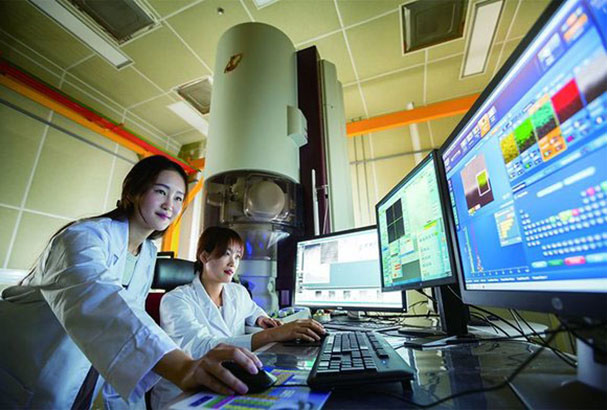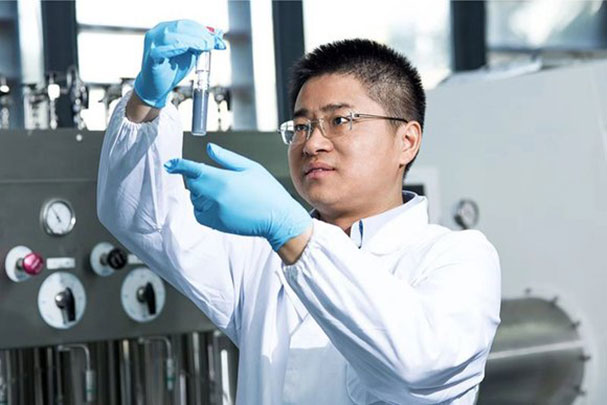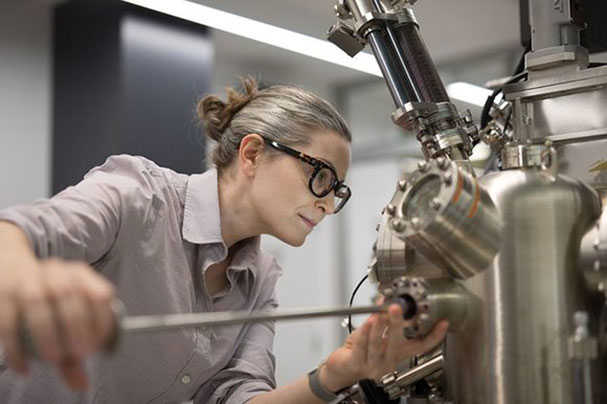
Gregoire Courtine and Leonie Asboth, whose studies on rats at EPFL led to an implantable device to help paraplegic patients.
Credit: Alban Kakulya/EPFL
Nine universities under 50 in the fast lane
These high performers are setting the pace in the race for solutions.
25 October 2019

Alban Kakulya/EPFL
Gregoire Courtine and Leonie Asboth, whose studies on rats at EPFL led to an implantable device to help paraplegic patients.
Swiss Federal Institute of Technology Lausanne
2018 FC: 219.92 | AC: 542 | Faculty: 4,700 | Students: 11,134 | PhD graduates: 2,216*
An implantable device that has restored the ability of three patients with paraplegia to walk is one of the most promising innovations in development at the Swiss Federal Institute of Technology Lausanne, Switzerland (EPFL).
The wireless implant, made up of an array of electrodes stretched over the spinal cord, targets individual muscle groups in the legs to mimic the signals fired in the brain when walking.
Volunteers in the clinical trial, David Mzee, Gert-Jan Oskam and Sebastian Tobler, have endured months of training and physical therapy to regain voluntary control over their leg muscles after several years of paralysis. They are now able to walk with the aid of crutches or a walker.
The study, published in two papers last year in Nature and Nature Neuroscience, is led by Grégoire Courtine, a neuroscientist at EPFL’s Brain Mind Institute, and Jocelyne Bloch, a neuro-surgeon at the Lausanne University Hospital (CHUV). The researchers saw continuous improvements in the patients’ motor function, even after the device was switched off.
The research follows a study published in early 2018, led by Courtine’s colleague, Léonie Asboth, which produced similar results in paralysed rats. The team observed for the first time how the brain can reroute motor commands through alternative pathways to the spinal cord.
“During a thesis, we all wonder at some point if what we’re doing is going to have an impact,” says Asboth. “Being able to see the first implications of this research on patients with spinal cord injury was very rewarding for all of us.”
An EPFL spin-off company, GTX medical, co-founded by Courtine and Bloch, is now developing the technology for use in hospitals and clinics. EPFL is exclusively licensing the patents to GTX medical, while also hosting many of its 40 researchers and clinicians.
Known formerly as the École polytechnique de l’Université de Lausanne, EPFL was established in 1969 as a university in its own right following a decision by the Swiss parliament to create a second federal institute of technology in addition to ETH Zurich. It is the third-highest ranked young university in the Nature Index and Switzerland’s only representative among the leading 100 young universities. — by Bec Crew
*includes technical staff
ShanghaiTech University
2018 FC: 36.34 | AC: 164 | Faculty: 521 | Students: 3,165 | PhD graduates: 41
China’s ShanghaiTech University’s high-quality research output has grown rapidly since its foundation in 2013. It is the world’s fourth-fastest rising young university and is ranked 22nd among the Nature Index Young universities.
Ning Zhijun, assistant professor in the School of Physical Science and Technology, says he was attracted to ShanghaiTech’s systematic materials science research, through which he and his team have produced high-profile papers in Nature, Nano Letters and ACS Nano.
“Unlike established institutions, ShanghaiTech as a new university does not impose heavy publication pressure on young scientists,” he says. “Our university offers generous research funding, so we can take on original studies that might not be published in the short term.”
Zhong Chao, a nanomaterials scientist in the physical science school, says that ShanghaiTech differs from older Chinese universities because its young scientists are not required to join teams of senior scientists when they are first recruited. This means they are free to explore their own research interests with fresh eyes.
“In a new university like ShanghaiTech, there aren’t so many established figures, so young scientists can independently take on some risky research, which is potentially more innovative,” says Zhong. Peer collaboration is also easy, he says, unencumbered by the need to consider seniority.
ShanghaiTech was jointly launched by the Shanghai municipal government and Chinese Academy of Sciences (CAS). As is the case with other young universities, it was not immediately permitted by China’s Ministry of Education (MOE) to recruit doctoral students in its own name, but CAS as a co-founder has helped it overcome this difficulty.
“CAS recruited doctoral students for us in the name of its Shanghai branch, and then transferred these students to us,” says Zhong. In 2018, the MOE allowed the university to independently enrol its first doctoral students in materials science and engineering. — by Hepeng Jia
Ulsan National Institute of Science and Technology
2018 FC: 68.88 | AC: 161 | Faculty: 322 | Students: 5,272 | PhD graduates: 116
Sang-Il Seok has a vision for his lab’s perovskite solar cells: covering the decks of a crude-oil tanker and supplying clean power to the vessels that haul the dirtiest of fuels. It’s a juxtaposition familiar to his university, the Ulsan National Institute of Science and Technology (UNIST), which is the tenth-highest ranked young university in the Nature Index.
The city of Ulsan is known as an industrial hub of South Korea, but since its establishment in 2009, UNIST has earned a reputation for clean energy research, including batteries and solar cells.

Hye Young Cho (left) and Young Shin Yoo at UNIST focus on new cells that are safer than conventional lithium-ion batteries. Credit: UNIST
“UNIST has become one of the strongest places to study green technology in Korea,” says Seok, a materials scientist whose research group specializes in solar cells that use a perovskite compound as the light-absorbing layer, which is easier to fabricate than more common materials such as silicon.
In 2017, Seok and his colleagues set the benchmark in perovskite-solar-cell efficiency of 22.1%. That benchmark has since been raised to 25.2%, just behind silicon at 27.6%.
Seok’s early success at UNIST was bolstered by funding for his lab of more than one billion South Korean won (US$826,000) from the university, part of an initial investment in its new campus.
UNIST’s focus on building a workforce skilled in new energy technologies is more important to the local community than ever, as the Korean shipbuilding industry, which was booming when the institution was first established, has suffered a significant downturn in recent years. “We need to educate the students who can get these good jobs in the near future,” says Seok.
Established to challenge South Korea’s top technical universities, UNIST mandated that all courses are to be taught in English to boost its international competitiveness. This is crucial for researchers in its Fluidics and Reactions Using Integrative Technology and Science (FRUITS) Lab, for example, who collaborate with EPFL in Switzerland, the National University of Singapore, and several teams in the United States on cell-to-cell communication, lab-on-a-chip technology, and nanodevices for use in medical research.
“There is no borderline in science,” says FRUITS Lab group leader, Yoon-Kyoung Cho. “Many of my students have learned self-confidence through active international collaborations. We have all our meetings in English, which was not easy in the beginning, but it becomes so natural that the students ask good questions at big international conferences, which makes me proud.” — by Mark Zastrow
Shenzhen University
2018 FC: 52.48 | AC: 179 | Faculty: 3,647 | Students: 34,156 | PhD graduates: 26
Following Shenzhen University’s (SZU) establishment in 1983, two of China’s top universities, Peking and Tsinghua, seconded teaching staff to the fledgling institution. The move was to support the city of Shenzhen’s development as one of four ‘special economic zones’ in southeastern coastal China, which were created in 1980 to attract foreign investment and technology.
High-profile alumni who have since cut their teeth at SZU include computer scientist, Ma Huateng, who is the founder and chief executive of the Chinese social media behemoth, Tencent, and software engineer, Shi Yuzhu, who set up the online gaming company, Giant Interactive Group. Alumna Tu Hongyan, now chairperson of Hangzhou-based silk brand, Wensli, was named one of Forbes’ top Chinese women in business in 2018.
Today, one of SZU’s most highly cited scientists is Zhang Han, a professor of optics and photonics. Han uses graphene and other two-dimensional materials to create laser photonics devices, which have applications in fields such as medicine, communications and quantum information science.

Zhang Han of Shenzhen University uses two-dimensional materials to create laser photonics devices. Credit: Shenzhen University
“Our research received heavy investment from the Shenzhen municipal government, which considers new materials as one of its priority high-tech industries,” Han told Nature Index.
Han joined SZU in 2013 as a ‘young thousand-talent’, part of China’s Thousand-Talent scheme, launched in 2008 to attract leading scholars. He says SZU’s advantages over more established universities in China include the encouragement it offers to young scientists who are keen to pursue new research areas, and its strong support for international collaboration.
The university has partnerships with 256 universities overseas for collaborative research and student training. It also has strong links to local industry due to Shenzhen’s status as a high-tech hub.
Last year the university’s total research budget exceeded 1.1 billion yuan (US$153 million), up from 100 million yuan in 2013, and it received 302 grants from the National Natural Science Foundation of China.
SZU is the third-fastest rising young university in the world and is ranked 13th among the Nature index Young Universities. It is also the third-fastest rising young university in the fields of chemistry and physical sciences. — by Hepeng Jia
Daegu Gyeongbuk Institute of Science and Technology
2018 FC: 19.99 | AC: 53 | Faculty: 260 | Students: 1,449 | PhD graduates: 26
When robotics engineer, Hongsoo Choi, visits his neuroscience collaborators to work on their medical microrobots, he doesn’t even have to walk outside. All six departments of the Daegu Gyeongbuk Institute of Science and Technology (DGIST) are housed within a tight cluster of buildings constructed in 2010. “It helps a lot, actually,” he says. “I can just stop by for discussions if I need. That’s a big advantage.”
The layout reflects one of the South Korean university’s core principles: ‘convergence’, its preferred term for an interdisciplinary mindset in research and study.
In May 2019, the team of roboticists, engineers and neuroscientists reported that they had created sphere- and helix-shaped microrobots that can deliver transplanted stem cells inside a live mouse. When a magnetic field is applied, the bots can roll along the walls of blood vessels or swim through fluids, carrying stem cells to their target.
In proof-of-concept experiments six years earlier, Choi guided microbots as they swam around plastic containers carrying kidney cell cultures. It was remarkable robotics, but rather mundane biology. “I wanted a more meaningful experiment,” he says.
This led him to the neuroscientists next door, who could culture neural stem cells from the hippocampi of mice, part of the brain involved with memory, learning and emotion. The study, published in Science Robotics, reports that the microbots could carry these tiny payloads until they differentiated into several types of brain cells. They also navigated the arteries of a dead rat’s brain, demonstrating the potential to deliver therapeutic cells to targeted areas to potentially restore brain functionality.
Choi’s team involves a number of young researchers with diverse expertise in robotics, such as Junhee Choi, who in a separate project helped to develop an ultrasonic device for root-canal treatment, and PhD candidate, Eunhee Kim, who focuses on the adhesion properties of microrobots in regenerative medicine.
DGIST, which was established just 15 years ago, actively encourages cross-disciplinary projects, as they have a better chance at being awarded internal grants, says Choi. “It’s not a rule, but it’s the culture.” The university is the seventh-fastest rising young university and is ranked 50th among the top young universities in the Nature Index. — by Mark Zastrow
Oregon Health and Science University
2018 FC: 55.48 | AC: 151 | Faculty: 2,900 | Students: 4,706 | PhD graduates: 28
Brian Druker, director of the Oregon Health and Science University’s (OHSU) Knight Cancer Institute in Portland, in the United States, is developing targeted treatments for acute myeloid leukaemia (AML), the most common form of blood cancer in the United States. This highly lethal disease affects the myeloid cells in bone marrow and kills more than 10,000 people in the United States annually.
Over the past 40 years, progress towards new, more effective treatments for AML has been slow. “There have been few changes in the way this form of leukaemia has been treated,” says Druker.
Two decades ago, Druker was involved in the development of the first targeted drug for chronic myelogenous leukaemia, a slow-growing form of leukaemia. The treatment, marketed as Gleevec, transformed the disease from a life-threatening illness to a manageable condition, with 90% of patients living for at least five years after diagnosis.
In 2016, Druker and his colleagues established the Beat AML programme, a long-term collaborative clinical trial that aims to uncover targeted treatments for various forms of acute myeloid leukaemia.
As part of this work, the team generated the largest data set of its kind, drawn from 672 tumour samples from 562 patients. The findings, published in Nature in October 2018, will help researchers pinpoint which genetic markers are sensitive or resistant to treatment, to inform future clinical trials.
OHSU, the former University of Oregon Health Center, became independent of the university in 1974, and was renamed in 1981. It is now the largest employer in Portland, and the only academic health-care centre in the state, comprising three campuses, two hospitals and numerous clinics.
OHSU is the most prolific young university in life sciences research output in the Nature Index, and is ranked 11th among young universities in the Nature Index.
Working at a relatively young institution has enabled Druker to “move quickly and get things done without having to navigate layers of bureaucracy”. Having the freedom to think outside the box is another advantage. “Being willing to embrace ideas that might be considered outside the mainstream has allowed us to develop new and paradigm-changing research,” says Druker. — by Gemma Conroy
Queensland University of Technology
2018 FC: 27.85 | AC: 117 | Faculty: 2,110 | Students: 47,592 | PhD graduates: 327
A synthetic material that can shift its structure under different light conditions has been developed by macromolecular chemist, Christopher Barner-Kowollik, at the Queensland University of Technology (QUT) in Australia.
When the material is exposed to green LED light, its chemical bonds strengthen to produce a hard, stable structure. In darkness, the material transforms into a soft, liquefied mass. Not only is the material reprogrammable, but it’s inexpensive to produce, consisting of just two chemical compounds. One of them, naphthalene, is an active ingredient in moth repellents.

QUT nanotechnologist, Jennifer MacLeod, is studying how to grow and modify two-dimensional materials. Credit: QUT
This light-stabilized dynamic material could be used as a 3D-printing ink for creating temporary scaffolds that support free-hanging structures, which are notoriously difficult to print using current methods.
In an effort to advance understanding of the material, Barner-Kowollik and his team published in the Journal of the American Chemical Society, in June 2019, rather than patent it, in the hope that other teams will explore its potential. They are part of an international collaboration involving Ghent University in Belgium and Karlsruhe Institute of Technology, Germany.
The QUT researchers are based in the university’s science and engineering faculty, which is one of the largest university faculties in Australia. They work alongside nanotechnologist, Jennifer Macleod, who uses scanning probe microscopy and X-ray photoelectron spectroscopy to investigate how to grow and modify two-dimensional materials, such as graphene.
QUT was established just 30 years ago, after operating for 20 years as the Queensland Institute of Technology. It’s the sixth-fastest rising young university, as tracked by the Nature Index, and is ranked 30th of the young universities in the index.
Whether it’s designing a new laboratory space or finding new collaborators, Barner-Kowollik says he’s able to effect change quickly at QUT, and has been given the freedom to explore new kinds of research questions. “Innovation occurs at the flanks of research, not within the mainstream,” he says.
QUT has two campuses in Brisbane, and in 2013, it opened the Science and Engineering Centre at its Gardens Point campus. In addition to teaching spaces and educational facilities, the centre houses the Institute for Future Environments, which brings together more than 300 scholars from different fields to collaborate on large-scale projects relating to natural, built and digital environments. — by Gemma Conroy
University of Paris-Sud
2018 FC: 71.08 | AC: 574 | Faculty: 4,300 | Students: 31,800 | PhD graduates: 688
François Costard, a geomorphologist at the University of Paris-Sud, is at the forefront of work investigating surface features on Mars for historic evidence of oceans. His latest paper, published earlier this year in the Journal of Geophysical Research: Planets, suggests that the Lomonosov crater in the planet’s north could have been the source of a mega-tsunami three billion years ago.
The scenario involves an asteroid collision of similar impact to the one that wiped out the non-avian dinosaurs on Earth 66 million years ago. In the case of Mars, it’s thought that the asteroid slammed into a shallow ocean, causing a massive wave to form. The research provides evidence that liquid water could have persisted on Mars for millions of years.
“This has implications for the total inventory of water on Mars, how it evolved, and the potential for the origin and survival of life on the red planet,” says Costard, director of the planetary geomorphology team at the University of Paris-Sud and director of research at France’s National Center for Scientific Research (CNRS).

A true alien landscape, these surreal sand dunes were photographed by the Mars Reconnaissance Orbiter near the red planet’s north pole. Credit: HIRISE/MRO, NASA/JPL/University of Arizona
He notes the advantages of research at a young institution like the University of Paris-Sud: “The youth of our institution favours the possibility of us having young research scientists and financial support for new, especially interdisciplinary, programmes.”
Originally part of the University of Paris, Paris-Sud was established as a university in its own right in 1970, and now has several campuses in the southern suburbs of Paris, including its main campus in Orsay. It is ranked ninth in the young universities in the Nature Index, and its highest subject rank is in the physical sciences, where it is also placed ninth.
In 2014, the University of Paris-Sud was a founding member of the University of Paris-Saclay, a ‘mega-university’ that brings together 19 universities, colleges and research centres in the south of Île-de-France. By 2020, when the University of Paris-Sud will be officially integrated into the University of Paris-Saclay, the consolidated institution will represent 15% of France’s total research output. — by Bec Crew
Hong Kong University of Science and Technology
2018 FC: 108.39 | AC: 310 | Faculty: 680 | Students: 11,205 | PhD graduates: 273
Despite being a relatively small institution, the 28-year-old Hong Kong University of Science and Technology (HKUST) has been consistently ranked among the world’s top young universities, noted for its growth and strong reputation.
In the Nature Index, HKUST is the fifth-highest ranked young university. It was ranked 32nd in the QS World University Rankings 2020, published by UK education company, Quacquarelli Symonds, and came second in its 50 Universities Under 50 ranking. It took the top slot in the 2019 Times Higher Education Young Universities Ranking for the second year running.
In addition to its traditional areas of strength — computer science, quantum physics and medical sciences — HKUST has achieved significant progress in molecular neuroscience, where researchers are investigating the proteins that promote the development of neurons and the mechanisms underlying neurodegenerative diseases, such as Alzheimer’s.
HKUST’s vice-president of research and development, Nancy Ip, says that the university’s flexible and efficient decision-making and its ability to define its own traditions and swiftly adapt to challenges have brought international recognition. She says the university’s location is also an advantage, facilitating collaboration with international and Chinese universities.
The career path of Qian Zhang, a computer scientist who joined HKUST in 2005 from Microsoft Research Asia, is an example of such collaboration. She has connected with a number of industrial partners, including Microsoft and Intel, to develop new wireless connection technologies. In 2009, she established a joint lab with Chinese telecoms giant, Huawei.
Zhang is the inventor of more than 50 granted and 20 pending international patents, and in 2016 became the university’s youngest endowed chair professor. “Compared with other more established universities in Hong Kong, the key to HKUST’s success is its openness,” she says. — by Hepeng Jia
This story is part of Nature Index 2019 Young Universities. See more stories here.
